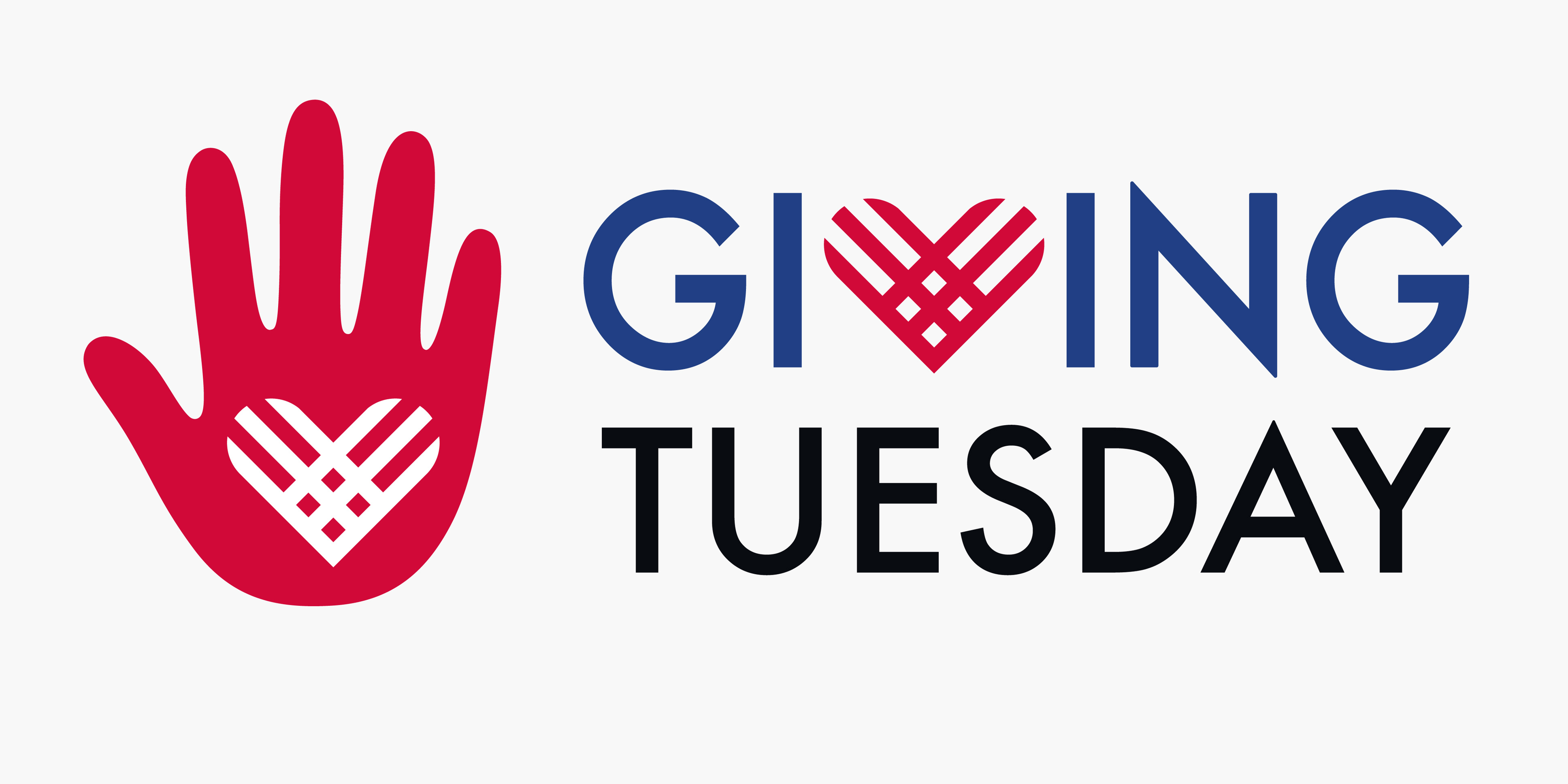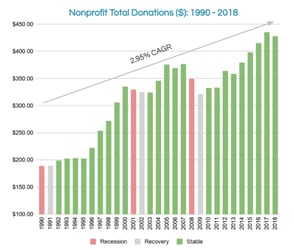So far, 2022 has presented many challenges for Americans; rising inflation, increasing numbers of layoffs, and Federal rate hikes have made consumers (and nonprofits) nervous about whether the country will fall into a recession in the near future.
Nonprofit organizations have a right to be concerned, but it’s not all doom and gloom. As we referenced in an earlier blog post, other indicators may demonstrate that nonprofits may not need to panic quite yet. The unemployment rate is currently at 3.7%, which is only slightly higher than the pre-pandemic rate of 3.5%. Furthermore, if we look at recessions over the past 30+ years we can see that the decrease in giving during and after recessions tends to be muted.
What Does This Mean for Nonprofits?
So, while we’re not in a recession yet, there are still some alarming economic signals out there. However, Windfall believes that your nonprofit can “recession-proof” fundraising initiatives by applying data-driven approaches to your end-to-end processes and workflows. By leveraging a data-first approach, your nonprofit can cut through all the noise in your database to:
- Find your high value and high propensity donors
- Better understand these donors
- Effectively engage with them to hit your fundraising goals, even during economic uncertainty
5 Data-Driven Steps to Power Giving Tuesday Fundraising
Giving Tuesday presents an excellent opportunity for your organization to test the following strategies. This global generosity movement, which was created in 2012, has inspired consumers from all around the world to donate and has raised larger amounts with each consecutive year. In fact, nonprofits raised $2.7B in 2021, which was 6% higher than the total from 2020, and 9% higher than what was raised in 2019.
Building on our previous post about Giving Tuesday in 2021, Windfall has put together 5 steps to ensure that your nonprofit can maximize fundraising for this year’s Giving Tuesday and beyond:
- Build a foundation of trustworthy data in your donor database
- Better understand your constituents through rich segmentation, reporting, and insights driven by machine learning
- Craft data-driven engagement and fundraising strategies
- Ensure enhanced performance by analyzing and measuring results
- Iterate on your data strategy to ensure future success
1: Ensure That You Understand Your Constituents with a Foundation of Trustworthy Data
Data-driven strategies must start with a strong foundation of accurate, reliable data. It’s vital to leverage both internal and external data to understand your donors and constituents. These insights will help you to improve engagement and retention, especially for major events such as Giving Tuesday.
Firstly, start with unifying your data. Duplicated, overlapping data across different systems is a challenge that many nonprofits face. Centralize your data into a single location so your organization has a source of truth when it comes to your internal constituent insights.
Once your data is centralized, you can apply the following internal attributes to better understand your constituents and how they engage with your organization:
- Donation frequency and amount
- Volunteer history
- Preferred method of giving
- Engagement history and preferences
Next, enrich your constituent data with wealth screening that provides not just actionable wealth intelligence but also delivers additional data points that can help you understand what resonates with your constituents:
- Philanthropic tendencies outside of your organization
- Foundation and nonprofit board association
- Career insights, such as job level, job title, and employer
2: Get to Know Your Constituents Through Rich Segmentation and Reporting
Now that your foundation is set, you can build out a wide variety of rich reporting to better understand your donors and constituents - these insights will help you to determine and drive your GIving Tuesday strategies. Here are some recommended methods to segment and analyze your donor database:
- Segment by wealth: Segment and sort your records by wealth to identify who’s affluent. Then add additional segmentation, such as donation history, trust association, and philanthropic tendencies, to further understand your affluent constituents.
- Segment your database by career data: Apply career insights in addition to wealth intelligence to understand your high value donors beyond affluence. Sorting by job level and job title can help you find constituents who are influential as well as affluent.
- Segment by donation history: Leverage donation attributes, such as date of last donation, frequency of donations, and average donation size to help you identify your high value donors, lapsed donors, and dedicated Giving Tuesday donors.
- Segment by engagement history: Donations aren’t the only way to see who’s passionate about your nonprofit. Sort by volunteer or event attendance frequency to see who donates the most in terms of their time and energy.
- Segment by philanthropic tendencies: Segmenting by external philanthropic attributes, such as preferred causes, foundation association, and nonprofit board membership can help you better understand your constituents’ philanthropic interests.
- Apply AI to identify high propensity donors: Leverage machine learning modeling to predict who is most likely to donate to your cause. Sort by propensity scores to easily identify your best prospects. To ensure the most accurate results, we recommend that the propensity model you use is customized for both your organization and your goal.
3: Determine Strategies Based on Constituent Intelligence and Insights
Now that you have a rich understanding of your constituents, you can effectively determine which strategies to leverage for your Giving Tuesday initiatives and beyond.
Strategies Leveraging Wealth Intelligence and More
While Giving Tuesday is typically focused on acquiring small donations from a larger audience, it’s important to remember that the number of donors has been shrinking over the past 20 years. We believe that it may be helpful to buttress wide-reach campaigns with additional strategies focused on affluent individuals.
- Multi-touch campaigns for affluent donors: Reach out to wealthy individuals with a call or handwritten note. Make sure to re-enforce those asks with targeted email requests and digital retargeting campaigns so your nonprofit stays top-of-mind with your most valuable donors.
- Engage hidden gems: Create a special program for your hidden gems, those donors who are high net worth, but have only donated small amounts. Personalize the ask amount for these donors by leveraging your wealth data to estimate gift capacity: Annual gift capacity = 1% X net worth.
- Re-engage affluent LYBUNTs and SYBUNTs: Apply donation history on top of wealth intelligence to identify affluent donors who are LYBUNT (those who donated last year but not this year) or SYBUNT (those who gave previously but not last year or this year). Use Giving Tuesday as an opportunity to reengage them, then leverage donation history to craft a story about how their donations have helped your organization in the past.
Career Intelligence Strategies
- Run an email campaign based on corporate matching gifts: Leverage employer data to determine which constituents belong to corporations that have matching gift programs. Then engage them in a targeted email campaign to remind them that their donations can go that much further.
- Determine Giving Tuesday ambassadors based on position: Look for constituents with jobs at the President, VP, or even CEO level. These levels are a good proxy for influence and impact within their company and community and can signal that they would be effective ambassadors for your campaigns.
- Personalize outreach with career attributes: Referencing constituents’ job titles or current companies is an easy way to personalize your outreach at scale, especially for direct mail or email campaigns.
Donation and Engagement History Strategies
- Target previous Giving Tuesday donors: Anyone who has given on Giving Tuesday is likely to have an affinity with special giving days. Make sure to engage them in a targeted campaign, thank them for past gifts, and ask for a new gift.
- Personalize messaging with donation history: If you solicit a donation without acknowledging that the recipient has given in the past, you risk losing that donor. Make sure to thank donors for their previous gifts and personalize your message with details like their last gift amount, date of their last gift, or total years of giving to your organization.
- Build a monthly donor program for small donors: Identify constituents who have never given over a certain threshold, then put them into an email drip campaign that encourages them to become monthly donors at smaller amounts, such as $10, $20, or $30.
- Create a special thank you program for your volunteers: Reach out to your top volunteers and participants to thank them for all of their hard work over the past year.
Philanthropic Tendency Strategies
- Align your Giving Tuesday messaging with the nonprofit categories that your constituents care about the most: Leverage this data to ensure that you’re telling the most relevant stories. For example, if the majority of your constituents donate to environmental causes, then you may want to highlight what your nonprofit is doing to support and protect the environment, even if it’s not your primary focus.
- Special campaign for nonprofit leaders: Use data points, such as foundation association and nonprofit board membership as signals for nonprofit leadership. Customize your messaging for these individuals, thanking them for their philanthropic leadership when asking for a gift.
Propensity Modeling Strategies
- Target affluent donors who have a high propensity to give: Layer PTG scores on top of wealth data to identify affluent donors who have the highest propensity to donate based on your threshold. Then reach out to them with phone calls and solicitations based on your target ask. Even if you have a model focused on those who are likely to make a major gift, a milestone like Giving Tuesday can be a good reason to engage those high propensity constituents and put your organization back at the top of their list.
- Target all donors who have a high propensity to give: If you have a PTG model based on your annual fund campaign, reach out to your constituents at scale through a multi-channel strategy across social media and email with your Giving Tuesday solicitation.
4: Analyze and Measure Results
After you launch your Giving Tuesday initiatives, make sure to measure the success of your campaigns. Go beyond total revenue raised and take a closer look at your campaign results to find helpful trends. We’ve listed some helpful KPIs below.
|
KPI |
Calculation |
Definition |
|
Fundraising ROI |
(Revenue - Cost)/Cost * 100% |
How much your organization made for each dollar you spent. |
|
Average Gift Size |
(Sum of Donation Amounts)/(Number of Donations) |
The average Giving Tuesday donation size. |
|
Donor Retention Rate |
(Last Year’s Donors/Last Year’s Donors Who Gave This Year) * 100% |
The percentage of donors that your organization retains on a year-over-year basis. |
|
Donor Growth Rate |
(Total Donors This Year - Total Donors Last Year)/(Total Donors Last Year)*100% |
The change in the total number of donors over a year. |
|
Email Open Rate |
(Total Number of Emails Opened)/(Total Number of Sent Emails)*100% |
The percentage of sent emails that were opened. |
|
Email Click Rate |
(Total Number of Unique Email Clicks)/(Total Number of Sent Emails)*100% |
The percentage of sent emails that were clicked on. |
Next leverage in-depth data visualizations to better understand your constituents and how they engage with your nonprofit. Below are examples of insightful visualizations:
Donation Distribution by Wealth (or Other Categories)
Understand your constituents by first segmenting them using an important attribute, such as wealth bins, favorite philanthropic causes, or career attributes. Then visualize the distribution of donation sizes for each category with a box and whisker plot. With this visualization, you can understand which segments bring the most value, or where there are areas of opportunity.

Average Donation Size and Total Revenue by PTG Score
You can also map the average donation size against propensity score bins for an easy-to-read visualization of your model’s overall performance. This visualization can be used to measure program impact and establish realistic monthly and quarterly objectives.
5: Take Advantage of Your Momentum and Iterate
Don’t wrap up your data-driven focus after Giving Tuesday ends. As you’re sending out thank you messages, make sure to think about how you can iterate on these strategies moving forward.
- Your data unification shouldn’t be a one-off event. Giving Tuesday will likely bring in many new donors and records, so continue to monitor your incoming data and resolve any data unification issues that come up.
- Make sure to screen any new donors who came in thanks to Giving Tuesday - you may find additional affluent donors whom you should cultivate. In fact, Windfall recommends screening your donors on a regular basis, so you always have the most up-to-date insights on both your new and current constituents.
- Based on the performance of your Giving Tuesday campaigns, make sure to refine your KPIs and goals for future initiatives. These insights will help you ensure that your goals are realistic and that you’re focusing on the right KPIs for each campaign.
- Better constituent insights will lead to more successful fundraising. Continue to segment and analyze your constituents to effectively drive future data-driven strategies and initiatives.
- If you’re leveraging propensity modeling, make sure to approach it as a continual learning exercise. Your constituents and their underlying scores will inevitably change over time. On top of that, your organization will most likely need to change objectives or approaches, which will impact your modeling results.
While the state of the economy looks uncertain, there are still reasons to remain optimistic. By leveraging Windfall’s data-driven strategies, you can make sure you’re going after the right donors and leveraging the best strategies to meet your fundraising goals for Giving Tuesday and beyond.
Sign up for a free Wealth Analytics Report to get a better understanding of what Windfall can do for you this Giving Tuesday.






